Table of contents
- Comparison test Ducati 1098S, Honda Fireblade, KTM 1190 RC8, Triumph Daytona 675, Yamaha YZF-R6 Test winner among themselves
- Ducati 1098S
- Honda Fireblade
- KTM 1190 RC8
- Triumph Daytona 675
- Yamaha YZF-R6
- Performance measurement
- Technical data – Ducati 1098S
- Technical data – Honda Fireblade
- Technical data – KTM 1190 RC8
- Technical data – Triumph Daytona 675
- Specifications – Yamaha YZF-R6
- Conclusion
- Country road setup
- How did it go in the race?
- The tires: Michelin Power Race
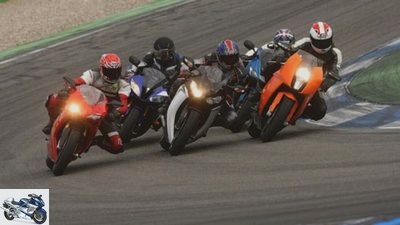
Jahn
motorcycles
Comparison test Ducati 1098S, Honda Fireblade, KTM 1190 RC8, Triumph Daytona 675, Yamaha YZF-R6
Comparison test Ducati 1098S, Honda Fireblade, KTM 1190 RC8, Triumph Daytona 675, Yamaha YZF-R6
Test winner among themselves
Content of
All those present here scored strong points in 2008 and achieved test victories; the most powerful was the new Honda Fireblade. But how does she fare when she faces four tough challengers? Ducati 1098S, KTM 1190 RC8, Triumph Daytona 675 and Yamaha YZF-R6 attack.
Robert luck
December 10, 2008
Frankly speaking: The Honda Fireblade tore a really deep crater into the world of sports motorcycles in 2008, so hard was its impact. First she ironed the also new Kawasaki ZX-10R, after which she only had to uncork one and provide traction control in the large PS test in Mireval (PS 5/2008) Ducati 1098R before she finally won the masterbike. In the tail of fire of the almost flawless comet, almost everything that came near it burned up.
But over the year there were other test winners in addition to the high-flyer; in other, but by no means worse, test fields. So it makes sense to organize another shoot-out, gather the best of the best and select the five? Ducati 1098S, Honda Fireblade, KTM 1190 RC8, Triumph Daytona 675 and Yamaha YZF-R6 ?? Letting go of each other on the country road and the race track. In series trim with original tires on the country road, in the Hockenheimer Kringel soled with Michelin racing skins. The fact that the French rubber has its peculiarities only became apparent during the test and caused some surprises. More details on this in the tire box below.
As usual, the curvy northern Black Forest was used as the test terrain, which with its variety of streets, lanes, smoothly ironed highways and badly scarred beet fields is ideal. In Hockenheim itself, the small course was tried to give the five muscle animals proper pouring.
Ducati 1098S
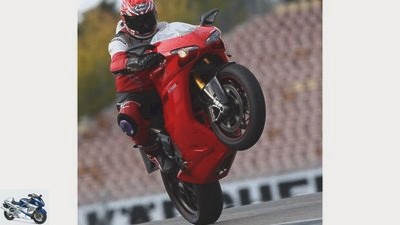
Jahn
Beauty and the beast in personal union: the chic Ducati 1098S is a force on the racetrack.
In contrast to the Honda, the 1098 its premiere on the motorcycle stage has been behind it for a while. Nevertheless, especially in the S version, it is both a feast for the eyes and an efficient driving machine. The S stands out from the basic version with its light forged wheels, fine Ohlins bones and data recording system, and with this noble equipment it not only helps the pilot to drive fast laps, but also to do them again later on the PC analyze.
Of course, the data recording is of no use on the country road. This is more about a balanced balance, playful handling and easily controllable engine power. While the Duc is a force on decent roads and the racetrack, a bit of martyrdom begins on second-rate tracks. In the PS test area in particular, the disparity between the shock absorber and fork adjustment is clearly noticeable. While the super-tight shock absorber distributes nasty blows and hardly does any damping work, the fork irons out almost any unevenness that you find underneath
Wheel is coming. It dips far when braking, but that bothers and influences the choice of line significantly less than the stubborn rear. This syndrome can only be changed with a softer spring at the back.
On the other hand, on the race track, the shock absorber praised the enormous performance of the 1099 twin, ensuring good rear wheel grip and very good feedback. The test crew was amazed at the driving behavior of the 1098S with the Michelin racing tires: the Ducati began to move slightly around its longitudinal axis on the relatively short start / finish straight. A phenomenon that the author has so far only been able to observe with a Ducati, a very poorly adjusted 996R at the end of the long parabolic steroids. With series tires, the 1098S is as fed up as the proverbial
board.
Honda Fireblade
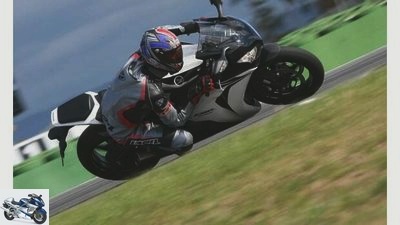
Jahn
Even after a year, not everyone has got used to the snub-nosed face of the Honda Fireblade. Its qualities are best explored with the stumps in hand.
The Fireblade struggles with very different problems than the red twin. Nobody wants to play with her, at least at the beginning of the test. Let’s take the petrol pump as an example: five motorcycles bunker the expensive juice, five testers lurk around the machines. The blade rider is the one who has to pay. Because when he comes back from the till, Yam, Duc, 675 and RC8 are already occupied. Just why? Because the Honda is an almost perfect motorcycle, but it radiates too few emotions. Compared to her two-wheeled colleagues, she seems unimaginative. In-line four-cylinder, aerodynamic fairing and a compact rear? finished. No banging of a large-volume twin massages the soul, no triple tubes warms the mind, and no sporting uncompromisingness à la R6 fascinates.
But the one who laughs last, laughs best: The Fireblade takes revenge, because this engine, hidden under the sucked-in plastic dress, simply cannot be bent. Coupled with the well-balanced and well-balanced chassis, it very quickly determines the number of strokes in the course. Thanks to great damping reserves and sensitive response, the chassis is always up to the brute performance. And if things get really bumpy, the electronically controlled steering damper helps to calm the load when accelerating; when braking hard, the slipper clutch thwarts bad rear wheel stamping.
Although the Blade, with its 200 kg full tank, is no heavier than the competition, it is the most unwieldy to handle. The longest crankshaft, which rotates at very high speeds in the crankcase, is particularly noticeable on narrow country roads and on the racetrack. It also stands out ergonomically from the test field. Although the Fireblade accommodates its pilot more sportily than ever, the Blade’s tank is still wide compared to the other four. The tight knee joint of a Ducati or KTM you just can’t do it with a four-cylinder.
How sensitive the Honda chassis reacts to changes was shown by the tire change to the Michelin: The high front tire in combination with the 50 mm cross-section of the rear tire ensured that the blade stood there like a chopper and no longer drove into the corners. Only the complete lowering of the fork and maximum spring base on the shock absorber brought the balance back into balance and the usual full steering and driving behavior.
KTM 1190 RC8

Jahn
A successful first serve from Mattighofen: The RC8 already found many fans in its first year. Now the fine-tuning can follow.
First of all, one thing has to be conceded to the KTM learners: For a debut, especially in this very narrow and bitterly contested world of super athletes, the RC8 is a tremendous achievement. Still in its infancy, already a PS test winner? Respect! But: Where there is light, there is also shadow, and where bright light shines, the shadow is all the darker. Exactly: topic engine, chapter manners, keywords smoothness and throttle response. Reworking is called for here, after all, and now we come to the very bright light, Ducati shows with the L-Twin in the 1098 how it can work. Soft throttle response, very low load change reactions, hardly any vibrations and brute performance. The Duc has everything, the KTM has none of it. In addition to all of this, there is a transmission that is only too happy to insert intermediate idle cycles and thus cause nasty surprises time and again.
The handling of the Alpenbrenner, on the other hand, is brilliant. For a large motorcycle, the RC8 works almost like a bicycle in an inclined position, only has to admit defeat to the small ones, i.e. the 675 and the R6. Unfortunately, the setup of the RC8 in the delivery state is less brilliant. PS drove an extra shift in which two men did nothing for half a day other than drive out the highway shot documented in the box on page 29.
Why is the RC8 so complicated? Because it behaves like a racing motorcycle. That means a minimal change to the setup, be it the height of the frame rear, damping settings or a change to the spring base, every action shows a result. This directness is unknown to users of Japanese high-volume bikes and quickly leads them into suspension nirvana. In addition, the window in which the RC8 chassis works harmoniously is very narrow; to hit it is difficult.
However, if you move within this function window, the RC8 opens up tremendously. With its superb brakes and very good fork, it can be crushed before corners. After the apex, the evenly playing twin man and mouse pulls at lightning speed towards the next odd and reconciles something for his rough manners. As for the facelift of the 2009 vintage, PS wants nothing more than a smoother engine and a chassis that is easier to adjust for hobby racers. But the Mattighofen-based company has certainly already seen it all on film and is working flat out on it.
I liked it at the Hockenheim roundabout KTM 1190 RC8 the horsepower test crew, even if, like the Ducati, they tended to swing a little with the French skins.
Triumph Daytona 675
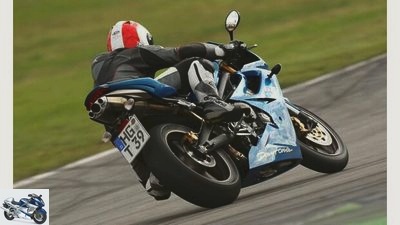
Jahn
Balanced instead of extreme: The Daytona 675 is primarily committed to being driver-friendly. Because if you are treated kindly, you can make quick laps.
It is tea time. What is not all said about tea: It is digestible, harmonious, relaxes the mind and inspires the soul. Well, while the 675 isn’t a chopped herb in a paper bag, it has the same characteristics. Especially if you are from KTM or the Yamaha If you switch to the three-cylinder, this balance is clearly noticeable. Your setup works very well in the black forest and still offers good reserves for the racetrack. No over-hard shock absorber like on the Twins maltreats the intervertebral discs, no 1000 cubic meters of the Fireblade stiffen the handling. In return, the Triple pushes nicely and, in contrast to the Screamer motor of the Yamaha, pushes properly in the four-digit speed range. Swinging curves becomes a pleasure, there is something heavenly about surfing fast arcs with your knee on the ground. The really nice thing about the Englishwoman is that she never has to, but always can. Strolling is allowed, but is rarely maintained in your saddle, as the relaxing wind pressure on your upper body is then missing.
And of course the subtle, muffled sound of the triple. How greedy does it sound when full load is called up in middle gear at medium speed? splendid! Above all, everyday pleasures dominate the 675. Its smoothness inspires in all respects, small exceptions such as the gnarled gearbox can be tolerated well. Its standard Pirelli Supercorsa Pro tires underline the sporty, but pleasure-oriented character of the 675. With powerful grip and neutral driving characteristics, it impresses both on country roads and on the racetrack.
Another surprise in Hockenheim with the Michelin Power Race: The Triumph can handle the higher cross-section of the front tire without changing the level of the chassis and is only slightly more unwieldy than on the production tires. The Englishwoman also misses the nervousness of the RC8 and the Ducati. She marches steadily towards the straight along the Hockenheimer north curve.
Yamaha YZF-R6

Jahn
Community of convenience: On the racetrack, the R6 is a competent, experienced and reliable cooperation partner – but not a friend for a leisurely afternoon.
A similar picture emerges on the YZF-R6. She also loses some of her light-footedness on the Michelin, although her series Dunlops are anything but hyper-agile skins. Nevertheless, it is impressive how incredibly bustling the R6 can be slammed into the corners in the Black Forest even on standard tires. If it gets tight and angular, Triumph and Yam scramble for the lead in the crowd. But only as long as the Yamaha driver ?? this designation fits here extremely well ?? turns violently and performs a tap dance freestyle at World Cup level on the gear lever.
The R6 only comes to life from 10,000 rpm? and then unfortunately very loud. What 20-year-olds might still like goes far too far for an experienced tester. Two out of five test drivers climbed the R6 only with earplugs. And that on the country road! So if you fire through the forest at an anti-social loud speed level and constantly plow the perfectly operable transmission, you are at the forefront. The chassis of the Yamaha rounds off the image of the merciless hunter with its taker qualities, works perfectly and also swallows rough waves and edges at racing speed.
The only question that arises again is why such a piece of sports equipment is delivered without a steering damper. The tendency to kick is low because of the sensitive and easy-to-swallow spring elements, but if she does kick, it can end badly.
Despite all the criticism that the R6 has to put up with: It is unique in its own way and a really cool device that generates the greatest driving pleasure. However, only if the pilot is willing and able to set it free. So it is not surprising that the Yam comes in first place in the racetrack rating, precisely because of its uncompromising character, next to the Fireblade, which is superior in terms of motor technology. The final difference between the two is a taste judgment. Here the R6 can be what it is: a consistent athlete who wants to win and does not accept any compromises.
Performance measurement
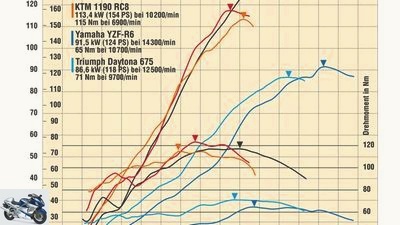
Power on the crankshaft, measurements on Dynojet roller dynamometer 150.
The Blade’s 1000cc four-cylinder towers above all others. Together with the Triumph-Triple it is the most harmonious engine and generates its power nicely evenly. The 675 lacks the sporty punch around the top. The RC8 also feels slightly weak despite its 154 hp; something of the wild character of the 1098S would do her good. Subjectively, the two twins are separated by more than just 6 hp. The Yamaha YZF-R6 is very special: its top performance is annoying and exhausting in everyday driving.
Technical data – Ducati 1098S
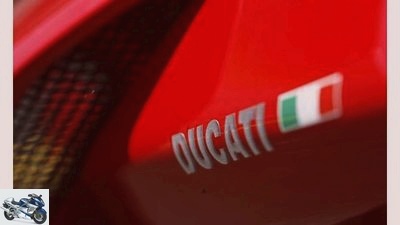
K
Drive: 90 degree twin cylinder V engine,
4 valves / cylinder, 119 kW (162 PS) at 9750 / min *, 123 Nm at 8000 / min *, 1099 cm³, bore / stroke: 104.0 / 64.7 mm, compression ratio: 12.5: 1, ignition – / injection system, elliptical 60 mm throttle valves, hydraulically operated multi-plate dry clutch, six-speed gearbox, G-Kat
Landing gear: Steel tubular space frame, steering head angle: 65.5 degrees, caster: 97 mm, wheelbase: 1430 mm. Upside-down fork, Ø fork inner tube: 43 mm, adjustable in height, spring base, rebound and compression. Central spring strut with deflection, adjustable in spring base, rebound and compression stage. Suspension travel front / rear: 127/127 mm
Wheels and brakes: Forged light alloy wheels, 3.50 x 17″/6.00 x 17″, Front tires: 120/70 ZR 17, rear: 190/55 ZR 17. First tires: Pirelli Supercorsa Pro. 330 mm double disc brake with radially screwed four-piston fixed calipers and radial brake pump at the front, 245 mm single disc with two-piston fixed caliper at the rear
Measurements and weight: Length / width / height: 2050/760/1100 mm, seat / handlebar height: 810/855 mm, handlebar width: 675 mm, 196 kg fully fueled, v./h .: 50.1 / 49.9%
Rear wheel power in last gear: 108 kW (147 PS) at 244 km / h
Driving performance: Acceleration 0 100/150/200 km / h: 3.1 / 5.1 / 8.1 s, pulling 50 100/100 150 km / h: 4.6 / 4.5 s
Top speed: 275 km / h *
Consumption: Fuel type: Super unleaded. Average test consumption: 7.2 liters / 100 km, tank capacity: 15.5 liters, range: 215 km
Base price: 21 295 euros (plus ancillary costs)
* Factory specification
| Horsepower rating – Ducati 1098S |
Technical data – Honda Fireblade
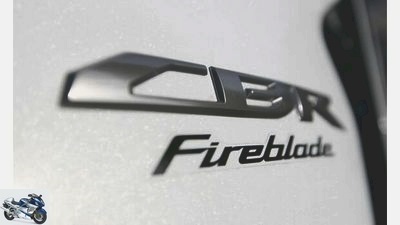
K
Drive: Four-cylinder in-line engine, 4 valves / cylinder, 131 kW (178 PS) at 12,000 / min *, 112 Nm at 8500 / min *, 1000 cm³, bore / stroke: 76.0 / 55.1 mm, compression ratio: 12, 3: 1, ignition / injection system, 46 mm throttle valves, mechanically operated multi-disc anti-hopping oil bath clutch, six-speed gearbox, G-Kat
Landing gear: Light alloy bridge frame, steering head angle: 66.8 degrees, caster: 196 mm, wheelbase: 1410 mm. Upside-down fork, Ø fork inner tube: 43 mm, adjustable in spring base, rebound and compression. Central spring strut with deflection, adjustable in spring base, rebound and compression stage. Suspension travel front / rear: 120/135 mm
Wheels and brakes: Light alloy cast wheels, 3.50 x 17″/6.00 x 17″, Front tires: 120/70 ZR 17, rear: 190/50 ZR 17. First tires: Bridgestone BT 015 “F.”. 320 mm double disc brake with radially screwed four-piston fixed calipers at the front, 220 mm single disc with single-piston floating caliper at the rear
Measurements and weight: Length / width / height: 2090/830/1130 mm, seat / handlebar height: 815/860 mm, handlebar width: 650 mm, 200 kg fully fueled, v./h .: 52.5 / 47.5%
Rear wheel power in last gear: 119 kW (162 PS) at 259 km / h
Driving performance: Acceleration 0 100/150/200 km / h: 3.3 / 5.2 / 7.6 s, pulling speed 50 100/100 150 km / h: 4.5 / 3.6 s
Top speed: 293 km / h *
Consumption: Fuel type: Super unleaded. Average test consumption: 6.5 liters / 100 km, tank capacity: 17.7 liters, range: 272 km
Base price: 13 760 euros (plus ancillary costs)
* Factory specification
| Horsepower Rating – Honda Fireblade |
Technical data – KTM 1190 RC8
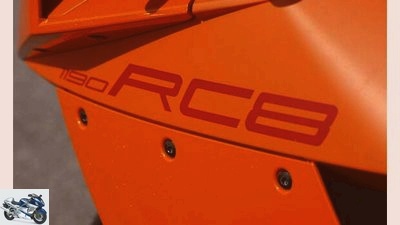
Jahn
Drive: 75-degree two-cylinder V-engine, 4 valves / cylinder, 114 kW (155 PS) at 9500 / min *, 120 Nm at 8000 / min *, 1150 cm³, bore / stroke: 103.0 / 69.0 mm , Compression ratio: 12.5: 1, ignition / injection system, 52 mm throttle valves, hydraulically operated multiple discs-
Oil bath clutch, six-speed gearbox, G-Kat
Landing gear: Steel tubular space frame, steering head angle: 66.7 degrees, caster: 92 mm, wheelbase: 1430 mm. Upside-down fork, Ø fork inner tube: 43 mm, adjustable in spring base, rebound and compression. Central spring strut with deflection, adjustable in spring base, rebound and compression stage. Suspension travel front / rear: 120/130 mm
Wheels and brakes: Light alloy cast wheels, 3.50 x 17″/6.00 x 17″, Front tires: 120/70 ZR 17, rear: 190/55 ZR 17. First tires: Pirelli Supercorsa Pro. 320 mm double disc brake with radially screwed four-piston fixed calipers and radial brake pump at the front, 220 mm single disc with two-piston fixed caliper at the rear
Measurements and weight: Length / width / height: 2060/820/1120 mm, seat / handlebar height: 820/900 mm, handlebar width: 740 mm, 201 kg fully fueled, v./h .: 52.0 / 48.0%
Rear wheel power in last gear: 105 kW (143 PS) at 246 km / h
Driving performance: Acceleration 0 100/150/200 km / h: 3.0 / 5.3 / 8.6 s, pulling speed 50 100/100 150 km / h: 4.6 / 4.5 s
Top speed: 280 km / h *
Consumption: Fuel type: Super unleaded. Average test consumption: 7.3 liters / 100 km, tank capacity: 16.5 liters, range: 226 km
Base price: 15 595 euros (plus ancillary costs)
* Factory specification
| PS rating: KTM 1190 RC8 |
Technical data – Triumph Daytona 675
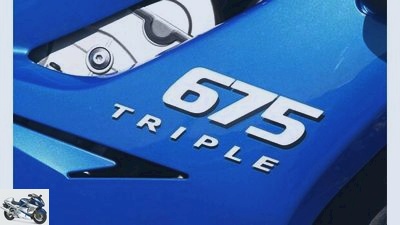
Bilski
Drive: Three-cylinder in-line engine, 4 valves / cylinder, 90.4 kW (124 hp) at 12,600 / min *, 72 Nm at 11,600 / min *, 675 cm³, bore / stroke: 74.0 / 52.3 mm, compression ratio : 12.7: 1, ignition / injection system, 44 mm throttle valves, mechanically operated multi-plate oil bath clutch, six-speed gearbox, G-Kat
Landing gear: Light alloy bridge frame, steering head angle: 66.5 degrees, caster: 87 mm, wheelbase: 1392 mm. Upside-down fork, Ø fork inner tube: 43 mm, adjustable in spring base, rebound and compression. Central spring strut with deflection, adjustable in spring base, rebound and compression stage. Suspension travel front / rear: 110/130 mm
Wheels and brakes: Light alloy cast wheels, 3.50 x 17″/5.50 x 17″, Front tires: 120/70 ZR 17, rear: 180/55 ZR 17. First tires: Pirelli Supercorsa Pro. 308 mm double disc brake with radially screwed four-piston fixed calipers at the front, 220 mm single disc with single-piston floating caliper at the rear
Measurements and weight: Length / width / height: 2047/765/1115 mm, seat / handlebar height: 850/850 mm, handlebar width: 660 mm, 190 kg fully fueled, v./h .: 50.9 / 49.1%
Rear wheel power in last gear: 81 kW (110 PS) at 224 km / h
Driving performance: Acceleration 0 100/150/200 km / h: 3.4 / 5.9 / 9.9 s, torque 50 100/100 150 km / h 4.7 / 5.5 s
Top speed: 260 km / h *
Consumption: Fuel type: Super unleaded. Average test consumption: 6.5 liters / 100 km, tank capacity: 17.4 liters, range: 268 km
Base price: 10 990 euros (plus ancillary costs)
* Factory specification
| Horsepower Rating – Triumph Daytona 675 |
Specifications – Yamaha YZF-R6
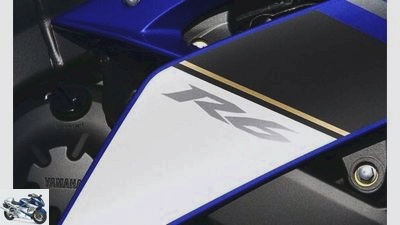
Bilski
Drive: Three-cylinder in-line engine, 4 valves / cylinder, 90.4 kW (124 PS) at 12,600 / min *, 72 Nm at 11,600 / min *, 675 cm³, bore / stroke: 74.0 / 52.3 mm, compression ratio : 12.7: 1, ignition / injection system, 44 mm throttle valves, mechanically operated multi-plate oil bath clutch, six-speed gearbox, G-Kat
Landing gear: Light alloy bridge frame, steering head angle: 66.5 degrees, caster: 87 mm, wheelbase: 1392 mm. Upside-down fork, Ø fork inner tube: 43 mm, adjustable in spring base, rebound and compression. Central spring strut with deflection, adjustable in spring base, rebound and compression stage. Suspension travel front / rear: 110/130 mm
Wheels and brakes: Light alloy cast wheels, 3.50 x 17″/5.50 x 17″, Front tires: 120/70 ZR 17, rear: 180/55 ZR 17. First tires: Pirelli Supercorsa Pro. 308 mm double disc brake with radially screwed four-piston fixed calipers at the front, 220 mm single disc with single-piston floating caliper at the rear
Measurements and weight: Length / width / height: 2047/765/1115 mm, seat / handlebar height: 850/850 mm, handlebar width: 660 mm, 190 kg fully fueled, v./h .: 50.9 / 49.1%
Rear wheel power in last gear: 81 kW (110 PS) at 224 km / h
Driving performance: Acceleration 0 100/150/200 km / h: 3.4 / 5.9 / 9.9 s, pulling speed 50 100/100 150 km / h 4.7 / 5.5 s
Top speed: 260 km / h *
Consumption: Fuel type: Super unleaded. Average test consumption: 6.5 liters / 100 km, tank capacity: 17.4 liters, range: 268 km
Base price: 10 990 euros (plus ancillary costs)
* Factory specification
| Horsepower Rating – Yamaha YZF-R6 |
Conclusion
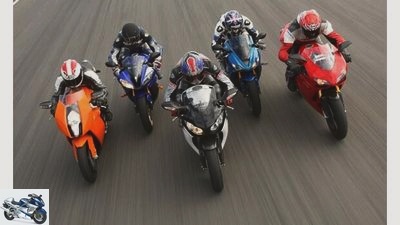
Jahn
The positions are related…
Conclusion: An exciting year is coming to an end and the positions have been taken. No motorcycle collects more points than the harmonious Honda Fireblade. The small Triumph is just as balanced to work, the Honda even outshines with its character? 2nd place overall. The two fascinating burners Ducati 1098S and Yamaha YZF-R6 share 3rd place, because they are both not flawless personalities, but value individuality. That’s what the KTM does 1190 RC8 also, but in this strong test field its small inadequacies and teething troubles are very noticeable; therefore only position 5.
Country road setup
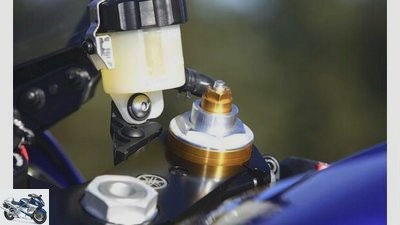
Bilski
Ducati 1098S
Fork: compression 5 clicks open, rebound 4 clicks open, spring base relaxed 6.5 turns
Suspension strut: Compression materials fully open, rebound stage 12 clicks open, spring base 10 mm preloaded
Honda Fireblade
Fork: compression 2.5 turns open, rebound 2.75 turns open, spring base 8.5 turns relaxed
Suspension strut: compression stage 2.5 turns open, rebound stage 1 turn open, spring base 4 of 10 stages preloaded
KTM 1190 RC8
Fork: compression 10 clicks open, rebound 10 clicks open, spring base preloaded 6 turns
Suspension strut: Compression stage high completely open, low 27 clicks open, rebound stage 10 clicks open, spring base 32 mm negative spring travel with pilot, eccentric “Low”, Stern down
Triumph Daytona 675
Fork: compression 10 clicks open, rebound completely open, spring base 5 rings visible
Suspension strut: compression 5 clicks open, rebound 3 clicks open, spring base 10 mm preloaded
Yamaha YZF-R6
Fork: high compression 2 turns open, low 14 clicks open, rebound 20 clicks open, spring base 2 rings visible
Shock absorber: high compression 3 turns open, low 15 clicks open, rebound completely closed, spring base 5 of 9 steps preloaded
How did it go in the race?
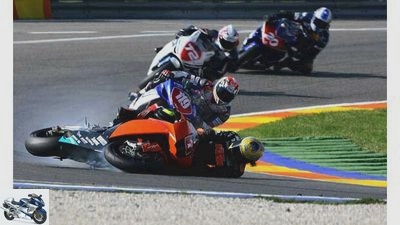
2snap
The KTM RC8 disappointed in its debut year. It is significantly weaker than its rivals.
Troy Bayliss secured the crown in the Superbike World Championship early with the 1098. In the International German Motorcycle Championship (IDM), the Duc took fourth place as the best place; in the final ranking, the best Ducatista is in 9th place.
In Germany, Honda’s Fireblade won the big cup, internationally it fell short of expectations. By the time of going to press (before the race weekend in Portugal) she won “only” 5 world championship victories. Currently lies
the top ranked blade driver in 5th place on the world championship table.
Things were sobering for KTM with the RC8: The Austrian followed in the FIM Superstock European Championship. So far, the RC8 with its two drivers could only get 5 points there.
In the IDM, the Triumph Daytona 675 won the title. She did not win international laurels, twice sixth place are her best World Cup results. In the table, the 675 is not in the top 15.
So far 8 pole positions and 2 victories for the Yamaha R6 in the Supersport World Championship. In front of Portugal, the best pilot is in fourth place in the table. In Germany, the Yam captured 6 victories and the runner-up title.
The tires: Michelin Power Race

mps studio
The French get something baked – pelts for the tough job: Michelin Power Race.
For use on the racetrack, PS put the five bikes on French standard tires, on the Michelin Power Race, which has been modified since March of this year. The front skin grew by 8 millimeters in diameter, has a stiffer carcass, a more pointed contour and bears the additional designation “C.” in the name of. The technical changes are intended to ensure greater stability and more nimble steering behavior. the “C.” are only allowed to play on closed-off routes, their mix corresponds to “Soft” of the conventional power race.
The technicians also further developed the rear tires to match the front tire. Their structure has also become more rigid, they are only available in sizes 180 / 55-17 and 190 / 55-17. Both versions are manufactured using 2CT technology, which means that they have compounds of different hardness in the center of the tire and on the sidewalls. For the rear wheel, Michelin offers the compounds “D.” and “E.” on; PS drove the test with the less wear-resistant “E.”-version.
When warmed up, the tires have enormous grip, the stability in an inclined position is the finest, and the same applies to the braking stability. The feedback becomes more transparent, the more the pilot loads the rubbers. In the cold state, the Power Race lacks this transparency a little. The new Michelins are not among the handiest skins; Most bikes race around with a little more nimble feet on their series tires.
In addition, the straight-line stability of the Ducati 1098S and that of the KTM RC8 suffers somewhat from the stiff construction of the Michelins: Both tend to stir slightly around the longitudinal axis. Despite late summer temperatures (18 ° C) and the air pressure recommended by Michelin (2.1 bar at the front; 1.9 bar at the rear), the tires, especially on the high-performance superbikes, showed clear signs of wear after just one hour of photo driving. The grip level remained pleasantly high for the rest of the day. vj
Related articles
-
Comparison test Kawasaki Ninja ZX-6R, Triumph Daytona 675, Yamaha YZF-R6
Fact 9 pictures triumph 1/9 Triumph Daytona 675 triumph 2/9 Triumph Daytona 675 triumph 3/9 Triumph Daytona 675 triumph 4/9 Triumph Daytona 675 triumph…
-
fact motorcycles Comparison test: Honda CBR 600 RR, Kawasaki ZX-6R, Suzuki GSX-R 600, Triumph Daytona 675, Yamaha YZF-R6 Comparison test: Honda CBR 600…
-
Honda CBR 600 RR, Kawasaki Ninja ZX-6R, Suzuki GSX-R 600, Triumph Daytona 675, Yamaha YZF-R6
Jahn 15th pictures Honda 1/15 For the model year 2009 Honda presents a facelifted CBR 600 RR. The well-known 600 cubic four-cylinder has been trimmed for…
-
Honda Fireblade, Kawasaki Ninja ZX-10R, Suzuki GSX-R 1000, Yamaha YZF-R1
fact 28 pictures Honda 1/28 Honda 2/28 Honda 3/28 Honda 4/28 Honda 5/28 Honda 6/28 Honda 7/28 Honda 8/28 Honda 9/28 Honda 10/28 Honda 11/28 Honda 12/28…
-
Bilski motorcycles Comparison test: KTM 990 Super Duke, Moto Morini Corsaro 1200 Veloce, Triumph Speed Triple, Yamaha FZ1 Comparison test: KTM 990…
-
Comparison test Ducati Monster 1200 S, Honda Fireblade, Kawasaki Z 1000 SX, Suzuki GSX-S 1000 F
jkuenstle.de 27 pictures jkuenstle.de 1/27 The disguised Suzuki GSX-S 1000 F has to prove itself in the field of competitors. jkuenstle.de 2/27 Nice is…
-
Jahn 31 pictures Photos: fact / Jahn 1/31 Honda Fireblade, Kawasaki Ninja ZX-10R, Suzuki GSX-R 1000, Yamaha YZF-R1, Ducati 1198S, KTM 1190 RC8 R and…
-
Comparison test: Honda Hornet, Kawasaki Z 750, Suzuki GSR 600
Jahn motorcycles Comparison test: Honda Hornet, Kawasaki Z 750, Suzuki GSR 600 Comparison test: Honda Hornet, Kawasaki Z 750, Suzuki GSR 600 ABS shooters…
-
Concept comparison: Kawasaki, Triumph, Yamaha
K motorcycles Concept comparison: Kawasaki, Triumph, Yamaha Concept comparison: Kawasaki, Triumph, Yamaha Fabric for Zoff Content of The liter is a handy…
-
Concept comparison: Honda Fireblade, KTM 990 Super Duke R, Suzuki GSX-R 600, Yamaha FZ6
Gargolov motorcycles Concept comparison: Honda Fireblade, KTM 990 Super Duke R, Suzuki GSX-R 600, Yamaha FZ6 Concept comparison: Honda Fireblade, KTM 990…